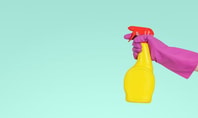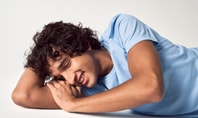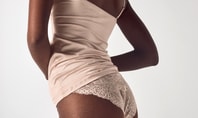Dress codes: which ones are there?
Have you ever been left wondering what to wear to a wedding because the invitation specified a particular dress code? Or are you someone who works in an office with a dress code and you just need a little more inspiration for what to wear on a daily basis? To make sure you’re neither underdressed nor overdressed in future, we’ve put together an overview of the most important dress codes for festive occasions and for the office.
by CALIDA
September 11, 2024•7 min reading time

Relaxed man in CALIDA basic loungewear, smiling and with a raised turtleneck.
Table of Contents
The five most important dress codes for evening events
• The most formal dress code: white tie
• The classic dress code: black tie
• The chic dress code: cocktail
• The casual evening dress code: semi-formal/informal
• The creative dress code: festive attire
The five most popular dress codes for work
• The formal workplace dress code: business formal
• The classic office dress code: business attire
• The professional dress code: business casual
The five most important dress codes for evening events
Fancy gala dinners, weddings, New Year’s Eve parties and other celebratory get-togethers often have a specified dress code. For other events, certain dress codes are just a given – even if they are not stated in advance. So that you know exactly how to style which dress code and when to wear it, we would like to introduce you to the five most common dress codes for evening events.
The most formal dress code: white tie
Expected at very official occasions such as state banquets or opera balls, white tie is the most formal dress code. It is the epitome of elegance and is accompanied by highly formal etiquette. White-tie outfits should therefore have the perfect fit and no flaws; the overall look must be characterised by the utmost sophistication.
For this dress code, men should wear a black tailcoat with silk lapels and matching black pants adorned with a silk stripe down the side. A white dress shirt with a white piqué bow tie should be worn under the tailcoat. Black, highly polished patent shoes, a white waistcoat, gloves and a simple watch round off the outfit.
Women are expected to wear a floor-length evening gown – usually in dark or muted colours – that’s made from luxurious fabrics such as silk or satin. They should opt for matching, closed-toe shoes with a mid to high heel, and simple, elegant jewellery. A small evening bag and long gloves provide the finishing touches.
The classic dress code: black tie
The ‘black tie’ dress code is also formal and is often worn at galas, awards ceremonies and weddings. It epitomises a sophisticated, elegant and refined style. In addition to black tie, there is also the ‘black tie optional’ dress code, which gives you a little more freedom, especially in your choice of colours.
For the ‘black tie’ dress code, men should opt for a black or midnight-blue dinner jacket with silk lapels. With the ‘black tie optional’ dress code, an anthracite-coloured dinner jacket is also acceptable. A black bow tie that is tied by hand is generally worn to provide a contrast to the white evening shirt, but a tie is also permitted for the less formal variant. The shoes should be classic black, and they should always be clean and polished. A cummerbund or a waistcoat can be worn if wished. Subtle cufflinks and a watch are also appropriate for black-tie events.
Women should wear a floor-length gown or an elegant cocktail dress made from high-quality materials. When it comes to ‘black tie optional’, the colours may be a little more eye-catching, and a stylish pant suit is also an option. Closed-toe or open-toe shoes with a mid or high heel may be worn, and jewellery should be understated and of high quality – the same applies to the evening bag. An elegant scarf or a stole is optional.
The chic dress code: cocktail
The ‘cocktail’ dress code is elegant and chic, but less formal than black tie. It is common at cocktail parties and formal celebrations, which often take place outside. This dress code offers greater fashion freedom and creativity than the previous dress codes. Nevertheless, it is important to dress stylishly and appropriately for the occasion.
For men, a dark suit with an elegant plain-coloured or discreetly patterned shirt is recommended for the ‘cocktail’ dress code. A tie is often worn, but is optional. Elegant, polished leather shoes and understated accessories such as a watch or cufflinks go well with cocktail attire.
As the name suggests, women may wear a knee-length (or slightly shorter) cocktail dress. The colours can vary, so both classic and trendy colours and patterns are acceptable. Elegant high heels or smart sandals are often chosen to match. Stylish jewellery and a clutch add the perfect finishing touch to a cocktail outfit.
The casual evening dress code: semi-formal/informal
The ‘semi-formal’ or ‘dressy-casual’ dress code is characterised by a mix of elegant and casual clothing. It is ideal for celebrations where a put-together but not overly formal outfit is expected. The ‘informal’ dress code is very similar to semi-formal, but is a little more casual and gives you a little more freedom.
For the semi-formal look, men often wear a dark suit without a tie or a blazer with dapper pants. This can be paired with a smart, often plain-coloured, shirt or polo shirt, as well as a pair of well looked-after leather shoes or trendy loafers. Understated accessories such as a watch or a belt round off the semi-formal or informal look.
With this dress code, women are recommended to wear a chic, mid-length dress, an elegant skirt with a blouse or a stylish pant suit. Semi-formal/informal gives you greater scope to show off your sense of fashion and individual style in your outfit than the classic dress codes. Elegant flats or mid-heel shoes, as well as tasteful accessories such as a handbag and understated jewellery, are ideal here.
The creative dress code: festive attire
The ‘festive’ dress code, or festive attire, is intended for occasions such as Christmas or New Year’s Eve parties where an elegant yet creative and festive style is expected. The clothing worn should reflect the festive character of the occasion but still be elegant and tasteful.
For this dress code, men can combine a dark suit with a coloured or patterned shirt that is appropriate for the festivity in question. Classic leather shoes or loafers that are well looked-after and clean also work very well for such an occasion. If you want to add festive accessories to this look, opt for an eye-catching tie or a stylish pocket square.
Women’s festive attire can also be a little more striking: lustrous or sparkling dresses, elegant jumpsuits or skirts with a festive top are ideal for this. These can be paired with fancy high heels or stylish sandals that complement the festive look. If you want to stand out even more, you can add eye-catching accessories, sparkling jewellery and a small, elegant handbag.
The five most popular dress codes for work
Dress codes are not only important at evening events. There are also occasions in the world of work where a certain dress code is required; for example, at job interviews, company events and, in many offices, even during the working day. Here are the five most important business dress codes, from formal to casual.
The formal workplace dress code: business formal
The ‘business formal’ dress code is a very classic, conservative business look that is expected to be worn, above all, at special business events or in very conservative industries, for example at banks or law firms. It stands for the highest level of professionalism and should be complied with strictly; a well-groomed appearance is just as important as the right items of clothing.
For the ‘business formal’ dress code, men should wear a high-quality suit in black, dark blue or anthracite. Just like the white or light-blue cotton shirt it’s paired with, this should fit perfectly and have no flaws. A plain, dark tie and black, polished leather shoes appropriate to the formal occasion are then added, along with accessories such as understated cufflinks, a classic watch and a simple black belt.
For women, dark pant suits or skirt suits that are paired with a white blouse are particularly suitable for business-formal attire. Here, too, the fit should be perfect. Mid-heel court shoes in black or dark brown are usually worn, and these should be closed-toe. Simple jewellery, a high-quality handbag and an understated belt round off the business-formal look.
The classic office dress code: business attire
The ‘business attire’ dress code is also a formal dress code that is common in many conservative industries such as finance and law, or in senior corporate positions. Representing professionalism, respectability and elegance, it allows a little more leeway than the ‘business formal’ dress code.
For men, a classic, well-fitting suit in muted colours is suitable for this style, paired with a long-sleeved shirt, which should generally be white, light blue or another subtle colour. Patterns such as fine stripes or checks are also acceptable. The tie, on the other hand, should be understated and elegant – it should match your suit colour, just like your leather shoes.
For women, the ‘business attire’ dress code may also be a little more eye-catching than the ‘business formal’ dress code. For example, suit pants and a blazer can be paired with a delicately patterned blouse, and worn with closed-toe, elegant mid-heel shoes, understated jewellery and a stylish, simple handbag.
The professional dress code: business casual
The ‘business casual’ dress code is less formal than business attire, but still professional. It is common in many modern offices and combines a respectable appearance with a little more comfort and room to express individuality.
With this dress code, men can pair a jacket with pants or chinos in a neutral colour. Both long and short-sleeved shirts in a plain colour or with a subtle pattern can be worn; a tie is optional. In addition to clean leather shoes or loafers, a discreet watch and a simple belt that matches the shoes may be worn.
For the ‘business casual’ dress code, women often wear an elegant blouse or a high-quality top paired with pants or a skirt. A simple dress with a blazer is also an option, and shoes with a low heel, ballet flats or loafers can also be worn. It’s perfectly fine if accessories such as jewellery and handbags are a little more on the trendy side, but they shouldn’t be anything too eye-catching.
The modern business dress code: smart casual
The ‘smart casual’ dress code is an even more relaxed version of the ‘business casual’ dress code. It is particularly common in creative and modern workplaces, and combines comfort with a stylish, well-groomed appearance. If you are unsure about the dress code, you should consider the occasion so as not to appear too casual.
For men, a combination of dark jeans or chinos and a polo shirt or collared shirt is particularly suitable for this dress code. A suit jacket is optional, as are leather shoes; clean trainers or loafers are also acceptable. Instead of a tie, simple accessories such as a watch or a matching belt can also be worn.
Women can follow the ‘smart casual’ dress code by opting for a simple dress, a trendy top or a blouse paired with nice jeans, a skirt or pants, for example. There are also plenty of options when it comes to shoes and accessories: flat shoes such as smart trainers or mid-heels and slightly more eye-catching yet tasteful accessories round off the look.
The laid-back office dress code: casual
The ‘casual’ dress code is the most relaxed dress code in the office and is used in very laid-back, often creative workplaces. This dress code places emphasis on comfort, although a neat appearance is, of course, still expected. With the ‘casual’ dress code in particular, it is important to take the corporate culture into account so as not to be dressed inappropriately.
For a casual office look, men can opt for a simple T-shirt, a polo shirt or a casual shirt, which they can pair with jeans or chinos. Comfortable but clean shoes such as trainers or loafers are perfect for this laid-back style, in addition to minimalist accessories such as a watch or a simple belt.
Women can also keep things relaxed with the ‘casual’ dress code. A simple T-shirt, top or blouse can be paired with jeans, comfortable pants or a casual skirt. Oversized blazers are also particularly on-trend. Flat shoes such as ballet pumps, trainers or comfortable sandals, understated jewellery and a practical handbag round off the casual office outfit perfectly.
Discover more interesting blog posts:


